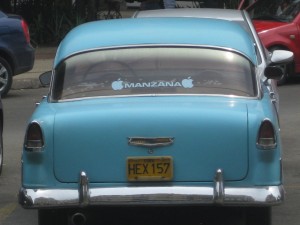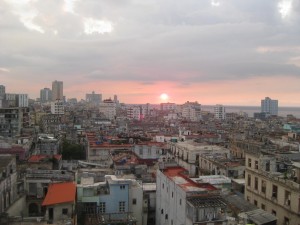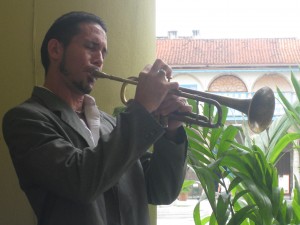 Bob and I recently returned from spending a week in Cuba on a sanctioned art tour with the Art Institute of Chicago. Although the U.S. government treasury department kept a tight leash on us (not wanting us to contribute to the Cuban economy by taking salsa lessons or lounging with mojitos on the beach) we never-the-less managed to drink a fair amount of Havana Club rum and smoke a few Cuban cigars while we were there. As a group we explored the art museums and the many biennial exhibits throughout the city, walked through five centuries of Old Havana, visited the homes of contemporary Cuban artists, dined with them, bought their artwork and music CD’s (yes, that’s legal), enjoyed live Cuban music in countless bars and restaurants, talked with the people in the streets and toured the countryside west of Havana on a Chinese tour bus with a very friendly, candid, pretty and extremely knowledgeable Habanera named Yaritza. Also accompanying us was Adrian, a multi-lingual Brit who has spent many months in Cuba. Adrian kept us on time and on schedule and helped make our week in Cuba the fantastic cultural experience it was.
Bob and I recently returned from spending a week in Cuba on a sanctioned art tour with the Art Institute of Chicago. Although the U.S. government treasury department kept a tight leash on us (not wanting us to contribute to the Cuban economy by taking salsa lessons or lounging with mojitos on the beach) we never-the-less managed to drink a fair amount of Havana Club rum and smoke a few Cuban cigars while we were there. As a group we explored the art museums and the many biennial exhibits throughout the city, walked through five centuries of Old Havana, visited the homes of contemporary Cuban artists, dined with them, bought their artwork and music CD’s (yes, that’s legal), enjoyed live Cuban music in countless bars and restaurants, talked with the people in the streets and toured the countryside west of Havana on a Chinese tour bus with a very friendly, candid, pretty and extremely knowledgeable Habanera named Yaritza. Also accompanying us was Adrian, a multi-lingual Brit who has spent many months in Cuba. Adrian kept us on time and on schedule and helped make our week in Cuba the fantastic cultural experience it was.
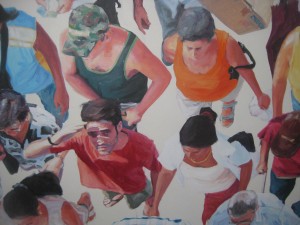 Our group was led by Regina Mamou, an expert from the Art Institute of Chicago, who helped us understand and better appreciate the art we were seeing. And let me just say, the Cuban artists are NOT painting pretty landscapes with coconut palms and hibiscus. We packed so much into those eight days (and nights!) I can’t begin to cover it all in one blog post.
Our group was led by Regina Mamou, an expert from the Art Institute of Chicago, who helped us understand and better appreciate the art we were seeing. And let me just say, the Cuban artists are NOT painting pretty landscapes with coconut palms and hibiscus. We packed so much into those eight days (and nights!) I can’t begin to cover it all in one blog post.
All of the old classic American cars make you feel as if you’re back in the 1950’s and the Cubans are the best mechanics. You never see one with less than five passengers because they help each other and give their family, friends and neighbors rides. While all are “high occupancy” the downside is the exhaust from these leaded gas guzzlers.
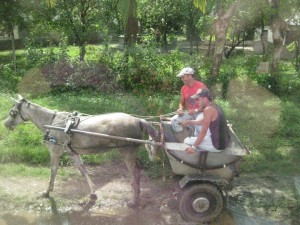 In the countryside horses are still widely used for transportation.
In the countryside horses are still widely used for transportation.
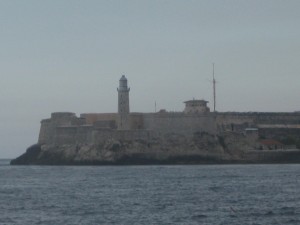 Personally, I was delighted to have the opportunity to see the Morro Castle, the stone fort that has been guarding the mouth of the Havana Harbour for more than five centuries; a landmark fort that played a significant role in my first novel, Star-Crossed (published by Knopf in 2006 and now out of print but soon to be republished as Barbados Bound by Fireship Press.) We toured the nearby Cabana, the largest fort in the western hemisphere, which overlooks the city, just south of the Morro. I was happy to see that my research, which was done entirely from books, manuscripts and websites, had been accurate.
Personally, I was delighted to have the opportunity to see the Morro Castle, the stone fort that has been guarding the mouth of the Havana Harbour for more than five centuries; a landmark fort that played a significant role in my first novel, Star-Crossed (published by Knopf in 2006 and now out of print but soon to be republished as Barbados Bound by Fireship Press.) We toured the nearby Cabana, the largest fort in the western hemisphere, which overlooks the city, just south of the Morro. I was happy to see that my research, which was done entirely from books, manuscripts and websites, had been accurate.
I return enthralled with Cuba — its history and culture, its literature and art. I would love to go back to study the history in greater depth. Unfortunately my country does not allow me to do that because of the embargo. Of course there are ways around that…
My next blog post will focus on the history of Havana as related to my historical fiction. Be assured Havana plays a role in “By a Yankee Moon” which I am writing now… Stay tuned for more about Cuba — past, present, and future — as I reflect upon what I’ve experienced and learned.
